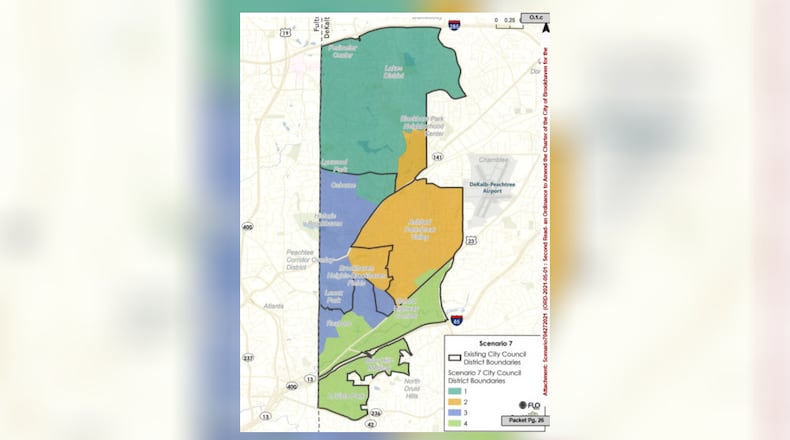Brookhaven city leaders approved a new council district map Tuesday, but they made sure to let residents know they weren’t happy about it.
DeKalb County’s most populous city decided to redraw its four council districts before November’s elections, but they did so without 2020 U.S. Census data. Due to the pandemic, the full dataset won’t be available until September, which is well after the state’s May 6 redistricting deadline.
During Tuesday’s City Council meeting, City Attorney Chris Balch explained why the city is taking this approach. Brookhaven, founded in 2012, has never reevaluated its districts despite multiple annexations east of I-85, leaving its population of 53,000 unevenly represented.
“That black hole creates a problem for the city, particularly when we suspected, reasonably I believe, that the districts were out of alignment and likely illegal,” Balch said, referring to the varying populations of each district. Georgia only gives a 10% margin for error with populations.
While every councilmember voted to approve the new map, which was created by consulting firm FLO Analytics, they remained frustrated. Councilmembers Madeleine Simmons and John Park said they understood it could prevent litigation, but they worried the city would just have to redo the process soon. The city has not said whether it’s received threats of legal action regarding redistricting.
“This goes against some of the feedback I’ve received from the community,” Park said. “It’s one of these things where I wish we didn’t have to do this, but as stewards of the city, it’s our responsibility to do so.”
Mayor Pro Tem Joe Gebbia, who recently announced he won’t be seeking reelection this fall, said he isn’t thrilled the map will split some areas, such as the Pines Hill neighborhood, between two districts. However, he conceded that it was the best temporary option.
“It’s a compromise. That’s what we’re here to do — pick the best of the compromises,” he said.
The city’s new district map, presented to the council and residents as scenario 7, estimates between 15,359 and 15,595 residents in each district. District 4, the southernmost and most populous, is also the only majority minority district in the city. It’s 44% Hispanic, 18% Black, 8% Asian and 28% white.
While not an explicit goal of the redistricting effort, the city’s newly formed Social Justice, Race and Equity Commission has placed new focus on representation within city leadership.
Neighboring Chamblee also added a fourth City Council district this year, which brought up similar questions about race, ethnicity and local representation.
Brookhaven initially considered five district maps and added three more after receiving input from a virtual town hall. Scenario 7 became the standout choice and was the only one presented ahead of Tuesday’s vote.
District lines will not drastically change. District 2 will expand west into District 3 and north into District 1, while District 3 will absorb some of District 4.
Balch said the city could redraw district lines again if Census data is “significantly different” from FLO Analytics’ calculations and estimates. But the new map will stand for at least the next election cycle.
About the Author
Keep Reading
The Latest
Featured


